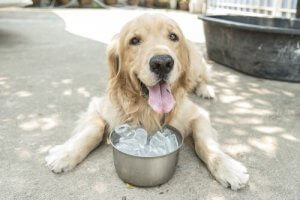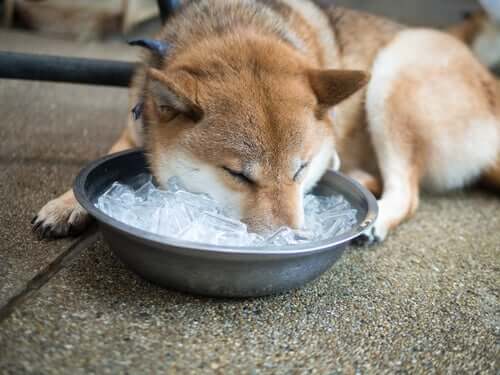Side Effects of Giving Ice to Dogs - Myth or Fact?


Written and verified by biochemistry Luz Eduviges Thomas-Romero
Year after year, in times of stifling heat we all have the inclination to offer our dog something refreshing, such as ice water and even ice. But is this safe? Are you familiar with the side-effects of giving ice to dogs? We’re about to tell you what we know about it.
The myth about deadly side-effects of giving ice to dogs
There’s a widespread belief that ice or ice water is dangerous for a dog. It can supposedly bloat their stomach and lead to acute gastric dilatation-volvulus syndrome, a life-threatening condition.
OK, but what’s acute gastric dilatation-volvulus syndrome (GDV)? Well, it’s a serious condition, with mortality rates ranging from 10% to 60%. Gastric dilatation or torsion occurs as a result of the accumulation of gas, fluid or a combination of both in an animal’s stomach.
Thus, the stomach distends with gas or liquid and goes along the esophagus and reaches the heart. Factors associated with the appearance of this syndrome include aerophagia, exercising immediately after a meal, and overeating.
The breeds most susceptible to this syndrome include large or giant, deep-chested dogs. This includes the Great Dane, the German shepherd, the standard poodle, and other large mixed-breed dogs.
Early diagnosis, medical stabilization, surgical intervention, and postoperative monitoring are important factors in preventing mortality.
Can ice intake lead to gastric torsion?

There’s no evidence that ice intake has to do with the development of GDV. The real danger to your dog comes from the animal consuming too much water at once. That is, drinking too quickly while swallowing too much air at the same time.
Despite the lack of danger of GDV, veterinarians don’t recommend giving a dog too much ice water after an intense playing session. Think about it, if you’re overheated and drink a glass of ice water too quickly, what happens then? Yes, it leads to pain and discomfort. Though it may not be harmful, why would you do this to your dog?
When a dog is hot and thirsty they’re likely to drink a lot of water too fast. Drinking too much water at once is a definite factor in stomach bloating.
To prevent bloating in your dog, feed several small meals a day instead of one or two large ones. Don’t let them drink a lot of water at once and avoid physical activity at least one hour after a meal.
Is dental impact one of the side-effects of giving ice to dogs?
Yes, in fact ice cubes are a common cause of teeth breakage in dogs. The larger and harder the cube, the greater the chances of it happening.
Actually, chewing anything hard significantly wears out tooth enamel. Give them smaller pieces or ground ice instead of large chunks in order to prevent dental problems.
Can the intake of ice in dogs lead to choking? Indeed, choking with a large ice cube is quite possible if the dog fails to chew it. Again, it’s better to offer smaller pieces of ice so it doesn’t happen.
Similarly, older animals with a weak denture or with advanced dental decay can’t chew as well and have a higher risk of choking. Similarly, dogs with respiratory difficulties or some form of a neurological disorder have an increased risk of obstruction with an ice cube.
It’s always a good idea to consult your vet if you’re concerned about your dog’s ability to chew and ingest ice cubes.
Can ice be used to cool down a dog affected by heatstroke?
Experts advise against the use of ice when the dog is overheated. The advice in these cases is to offer cold water, but no ice. The dog should be able to cool down gradually to avoid sudden vasoconstriction.
It’s also important to promote the cooling process without delay during heatstroke. Wet the dog with water at room temperature, mainly on their belly and back and not on their head. Then, take them to the vet as soon as possible.
Even if you manage to control the heatstroke at home, take them to the vet for a checkup to make sure there’s no internal damage. It’s important to recognize the symptoms of heatstroke: redness of the gums, vomiting, loud noises, wobbling, confusion, difficulty breathing, hot skin, and thick saliva.
Thanks for reading, we hope you’ve enjoyed this article.
All cited sources were thoroughly reviewed by our team to ensure their quality, reliability, currency, and validity. The bibliography of this article was considered reliable and of academic or scientific accuracy.
- Carrillo, J. D., Escobar, M. T., Martínez, M., Gil-Chinchilla, J. I., García-Fernández, P., & Jiménez-Peláez, M. (2016). Síndrome de dilatación-vólvulo gástrico (DVG). Clínica Veterinaria de Pequeños Animales, 36, 163-177.
- Hernández, C. A. (2010). Emergencias gastrointestinales en perros y gatos. Revista CES Medicina Veterinaria y Zootecnia, 5(2), 69-85.
- Bruchim, Y. (2012). Canine heatstroke. Israel Journal of Veterinary Medicine, 67(2), 92-95.
- Eisenburger, P., & Safar, P. (1999). Life supporting first aid training of the public—review and recommendations. Resuscitation, 41(1), 3-18.
This text is provided for informational purposes only and does not replace consultation with a professional. If in doubt, consult your specialist.